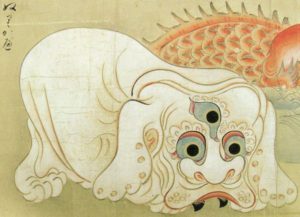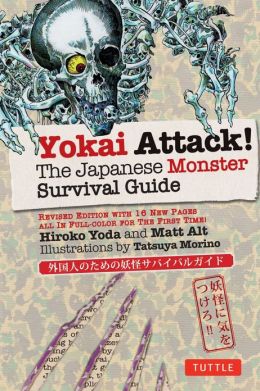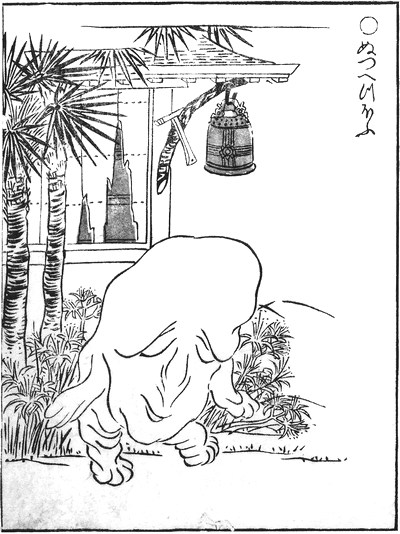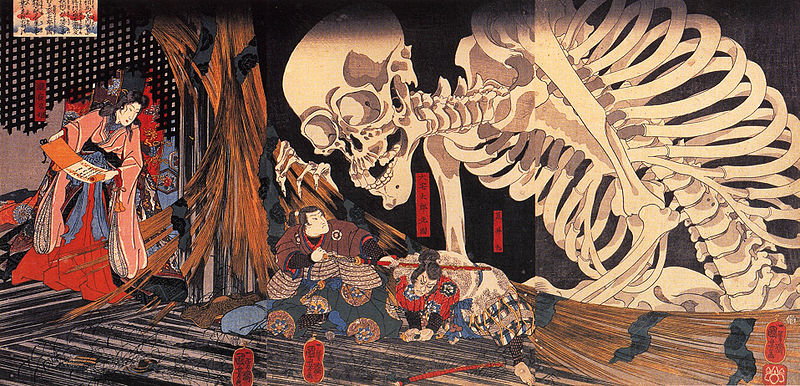
Somewhere between overtly deadly and mildly irritating is the Nurikabe, a being originally said to haunt the coastal regions of Fukuoka Prefecture. The Nurikabe has allegedly tormented Japanese travelers for centuries by quite literally acting as a ghostly wall–the monster is said to block roads, continually extending as the hapless wayfarer attempts to circumvent the invisible obstacle. The yokai forces travelers far out of their way, and was often blamed when people arrived late or became lost on the road. The Nurikabe could be defeated by taking a stick and striking at the bottom of the wall.
What makes Nurikabe interesting as far as Yokai go is that the ghostly apparition is a case study in how depictions of folklore change over time. The being was originally said to be completely invisible, or in some cases it was attributed to the mischievous tanuki.
Over time, however, Nurikabe took on a more corporeal form. a painting from 1802 (seen above) depicts the monster as looking a bit like a three eyed elephantine creature. Perhaps there were intermediate forms of Nurikabe depictions yet to be discovered, since going from invisible to an elephant monster is quite a leap, but it does demonstrate how over time ideas about folkloric stories change immensely.
But perhaps the most famous depiction of Nurikabe comes from a man who allegedly encountered one himself. The beast is a character in Mizuki Shigeru’s Gegege no Kitaro series, a long running manga about the adventures of various folkloric creatures. The character in the manga is depicted as a wall with eyes, arms, and legs.
Mizuki was partially inspired in his depiction by an encounter he claims to have had during World War 2 while stationed in New Guinea. Walking alone though the jungle at night, he suddenly was unable to move forward or backward. Walled in, Mizuki sat on the ground and rested, and was able to continue his progress after only a few minutes.
Mizuki’s depiction of the once invisible phenomenon has now become the standard way the Japanese visualize the Nurikabe. While Americans are less aware of this fairly obscure yokai, it appears to have had some influence on the iconic Mario Bros game series. The Whomps, tall blocks of stone with arms, legs, and faces, appeared in Mario 64 and have since been featured in many Mario games, at least superficially resembles Mizuki’s nurikabe. While it is difficult to tell if the Whomps were directly inspired by nurikabe, the appearance of the two beings are at least similar enough to infer that the folklore had some influence, even if it was strictly unconscious.
Nurikabe might not be quite as colorful and interesting as some of the wackier Japanese monsters, but they do shed light on how folklore evolves over time. Folklore is constantly being re-imagined as new generations with access to new technologies come into contact with old stories. From the intricate paintings of the Edo period to the pages of a manga to the world of video games, the Nurikabe is an ancient ghost who has evolved substantially over time as people have come reinvented the story to fit their own vision.
Sources:
Foster, Michael Dylan. “The Book of Yokai: Mysterious Creatures of Japanese Folklore.” University of California Press. January 14, 2015. pgs 140-141.
Yoda, Hiroko and Alt, Matt. “Yokai Attack: The Japanese Monster Survival Guide.” Tuttle Publishing. July 30, 2013. pg. 31.




Hi,
I am a big fan of Nurikabe puzzles – the logic puzzles, which is completely different to what you are talking about here. There are some interesting links though. Thanks for sharing, this is really interesting.
You know, it’s funny you should mention the puzzles. I actually had some trouble doing research for this post because when you type “Nurikabe” in Google, most of what you see is about the puzzles! I need to take a look into them though–not a big puzzle guy, but a little brain teaser now and then is good for you. Thanks for commenting!